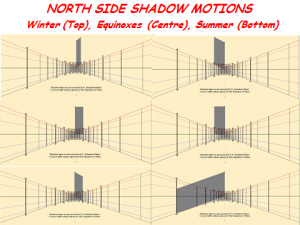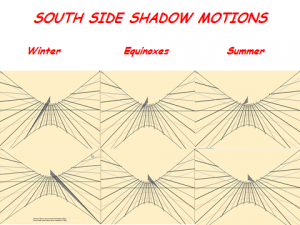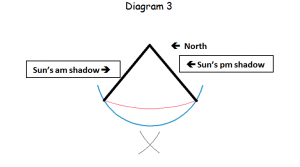The Hermanus Astronomy Centre recently erected a pair of back-to-back sundials in Swallow Park in the centre of Hermanus as part of the upgrading of this historical public park by the Ward committee. Since these two are intended to be the first of many different design sundials to be erected in Hermanus by the HAC, the designs were purposefully chosen to be “unusual” to illustrate the point that even unfamiliar designs and orientations give the same end result. Their location in a freely accessible public park dictated material choice to be as vandal-proof as possible: engraved polished granite for the sundial faces, gnomons as small as possible in stainless steel and explanatory plaques firmly epoxied onto a sandstone-dressed plinth that matches the style of the benches and other structures in the park.

The Northern, South facing sundial is a Polar design, with the sundial’s face mounted at the sundial’s Latitude of 34 o 25’ 14”, which has a number of implications: Its gnomon or style must be rectangular (see Fig. 1), the Sun will always describe full circles around the gnomon and the hour lines are therefore parallel as the Sun’s shadow moves from West to East (right to left in Photo 1). The hyperbolic declination lines trace the gnomon’s tip shadow at various times of the year. Fig. 2 illustrates how the winter, equinox and summer shadow motions move along the solstice and equinox declination lines. Steve Kleyn, who designed the sundials, included two intermediate declination lines between the solstices and equinox. This has the interesting implication that one can infer the approximate date by interpolating between two adjacent declination lines. “Clever” is a comment I’ve heard!

The Southern, North facing sundial is an even rarer Declining design (Fig 3) in which the gnomon is once again pointing to the South Celestial pole, whose shadow is cast onto a plane inclined at 15 o to the horizon.

Even though this sundial will not cast a usable shadow throughout the year, the declining angle was chosen to maximize the amount of usable shadow throughout the year. This sundial also has two intermediate declination lines between the solstices and equinoxes, but the hour lines are no longer parallel because the sundial plane is not parallel to the Earth’s rotation axis. It is however still possible to deduce the approximate date by interpolating the gnomon tip shadow between adjacent declination lines. The longer shadows cast on this sundial enables one to read the time more accurately than on the Polar design, where the bunching of the hour lines near noon make accurate readings rather difficult. Fig. 4 shows the gnomon’s shadow motion along the solstice and equinox declination lines.

On the East and West sides of the plinth there are stainless steel plaques explaining the origin of the Equation of Time, or time correction value, and graphically depicting it a follows:
“Time read off a sundial is local “Solar Time”. Compared to the time given by a reasonably accurate clock it will be different each day. Depending on the time of year it can be up to 16 minutes faster or 14 minutes slower. This is caused by two main factors:
1. From one day to the next, Earth has moved on its orbit. The sun’s angle, and thus time shown, changes every day by about 11 minutes depending on the time of the year. Earth’s orbit around the Sun is elliptical, causing it speed up when nearest and slow down when furthest from the Sun.
2. Earth’s axis is inclined at approximately 23 degrees to the Sun’s celestial equator changing the altitude of the Sun during the year. The projection of a shadow is thus also affected.
The combined effect produces the double sinusoidal curve of the graph of The Equation of Time. The factors vary over a period of 4 years, and then return to the same values. The Equation of Time Curve given here is averaged over 4 years. Correction of Local Time to SA Standard Time is included.”



Fig. 6 shows the plaque on the plinth.
Immediately below both sundials there are two different graphs from which the Equation of Time can be read off as function of date (Fig 7). A conventional XY-graph and a much more interesting analemmatic version, which also shows the declination (celestial equivalent of latitude) of the Sun.
Even though the construction materials of sandstone plinth dressing, polished and engraved granite sundials and stainless steel plaques were dictated by external factors the combination form a complimentary contrast which is aesthetically pleasing.

Left: Fig 8
It is fantastic to note that the sundials are 100% Hermanus “indigenous”: The design is by Steve Kleyn of the Hermanus Astronomy Centre, the granite and stainless steel from local suppliers (Southern Granite and Exclusive Works) and the engraving on both the granite and stainless steel by LES Engravers. The in situ determination of North was done by the “broom stick” Boy Scout method depicted below in Fig 9 & 10.


Fig. 11 indicates a measurement accuracy of better than 10mm at φ3.5m for the East point, and Fig 8 shows the casting template in position.



Fig 12 shows the final epoxying and screwing into place by Steve Kleyn and Chris Theron, while Fig 13 shows the Mayor’s reaction to what can only be described as an aesthetically pleasing, utilitarian and educational structure – another one of Steve Kleyn’s worthy legacies.
Click here to download a PDF version of the article which appeared in MNASSA magazine…

